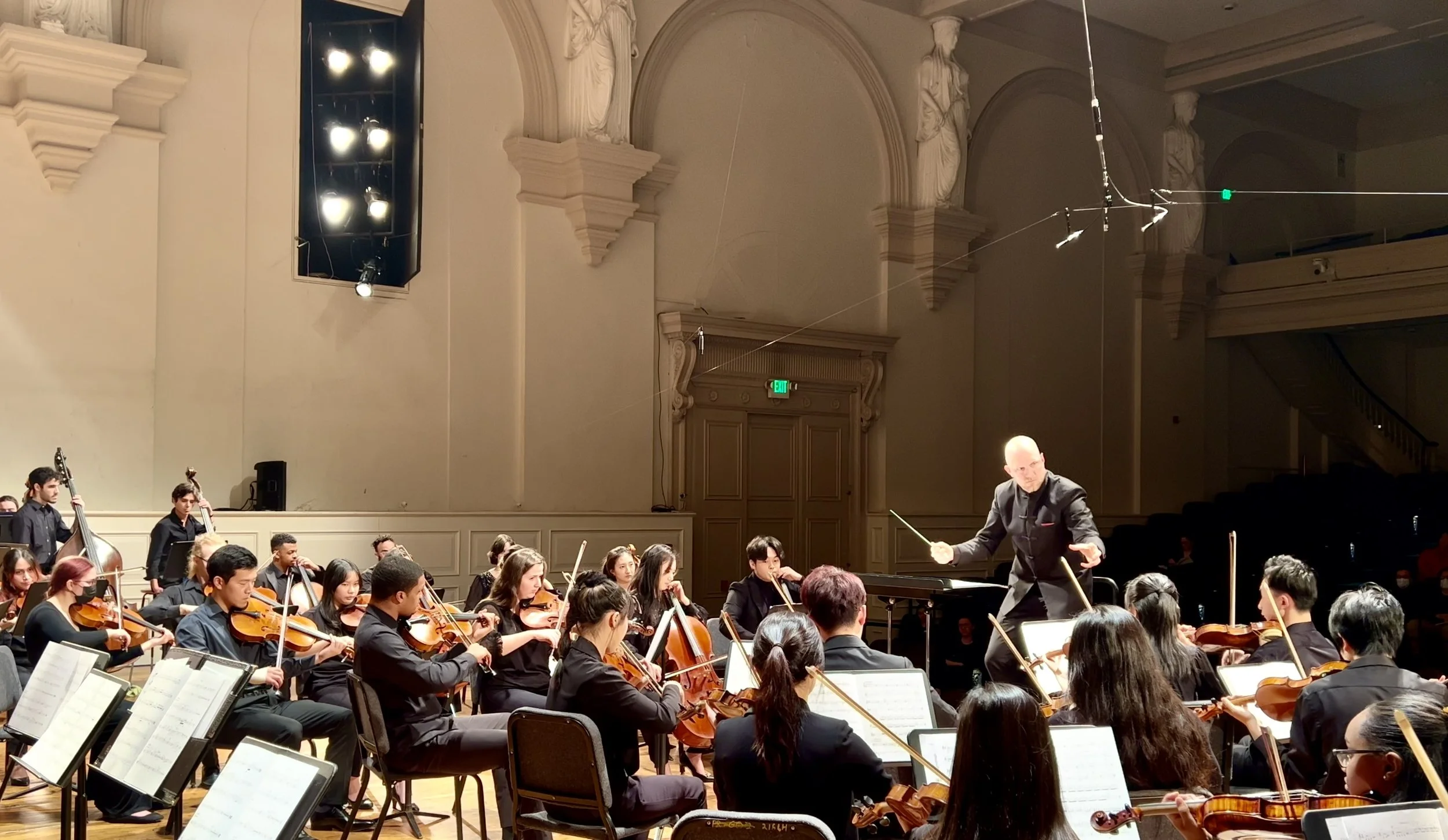In rehearsal with the Peabody Symphony Orchestra, February 2023.
Rehearsal time is a precious resource when working with a large orchestra. Nowhere is that more true than when working on new music. Time may be short enough that even a conventional piece of music would be difficult to prepare in the time available. Added to that, the many complexities of contemporary repertoire may create a very long list of questions that conscientious orchestral musicians will come to rehearsal needing answers to before a read-through is possible.
Some common and vital questions (including tacit questions) include:
Are the 5/8 bars grouped 2+3 or 3+2? (Similar questions for any odd meter bar.)
After the meter (and/or tempo) change, does the beat stay constant, the pulse, or is there an unusual (or no) relationship?
Does the rallentando elide directly into the next tempo or is the next tempo faster (or significantly slower) than the end of the rallentando? (Reverse for accelerando.)
Will the conductor be in 1/2/4/8//1/2/3/6/12/etc.?
Is the following movement played attacca?
All of this comes before we get into individual part questions.
Excerpt from my performance indications template.
To save hours of collective time, I use a performance indications document (I’ve sometimes seen this called a flow sheet). I try to make an attractive document using a template I create in Pages that maps out tempo, meter, beat patterns, tempo relationships, and occasionally gives stylistic insight in passages that may be hard to decipher on the individual part.
Now, in a professional or university context with weeks of lead time to communicate with librarians, get markings in parts, and get parts in folders, this document may be mostly superfluous, but perhaps not entirely. For instance, there may be program note information that would be of use to the musicians, and bring them into the creative process, and certain indications that probably shouldn’t be marked into their parts, but would serve as a useful reference.
However, there may be many other times where this approach might be useful. For instance, the example I include below comes from a piece I recently premiered after three rehearsals and only 9 days with the score, and in which I could not rely on librarians, nor could I delay part distribution, which had taken place at the same time I received my score. It was part of a new music reading session with the Peabody Symphony Orchestra.
In other cases, one might encounter a set of parts in which it would be inappropriate and/or impractical to erase them fully with the time or resources available. Again, a performance indications document like this may come in handy to help cut through the noise of an already marked part.
In all cases, musicians appreciate knowing the upper tempo ceiling on faster technical passages, and the lower end for slow sections requiring special control, so one way or another, those tempo markings should be given whenever possible, or at least expressed as a general range.
World premiere of Yan Fang’s Return to Dust for large orchestra. Watch video.
Lastly, even if it isn’t meant for distribution, it is a great way for conductors to be forced to reckon with a lot of the important information about a composition that can serve as a scaffolding. In those cases, I’ve increasingly turned to creating a version of this in my personal notes system so that I can review the functional aspects of a large composition at a glance.
In my performance indications document, I try to provide the following.
Basic Details of Performance
Title
Composer Name
Information Compiler (me)
Ensemble
Summary of Rehearsal and Performance Dates, Location, and Circumstances
Work Summary
I try to provide a summary that is not necessarily identical to the composer’s note in the score (though that might be an alternative or a preference for some). Instead, I to keep my focus on the mostly practical, while still giving the briefest outline of what the piece is about or how it works in just a sentence or two. Anything to help the musicians hold the entire piece together in their minds.
Movement Flow
For each movement, I try to walk the musician chronologically through the major touchstones that reflect issues that every musician will want to know. Some steps might include the following:
List the movement name (if it has one) and number.
Name the opening tempo marking in the score and provide a tempo or tempo range.
Give an indication of the beat pattern I plan to use.
Continue providing similar information at each major section, including key/meter/tempo changes.
Indicate odd-meter bar groupings.
Indicate whether there is a pause before the next movement.
Explain any major details that may only be clear when looking at the full score.
For a sample, see the image above. I’d be happy to send this template to any conductor who would find it useful. I’m also interested to know how other conductors manage some of the same issues of performance that I’ve described here. Do you use a similar document or have you found other circumstances dictate a different procedure? Please get in touch and let me know what you do or how you think about it!



